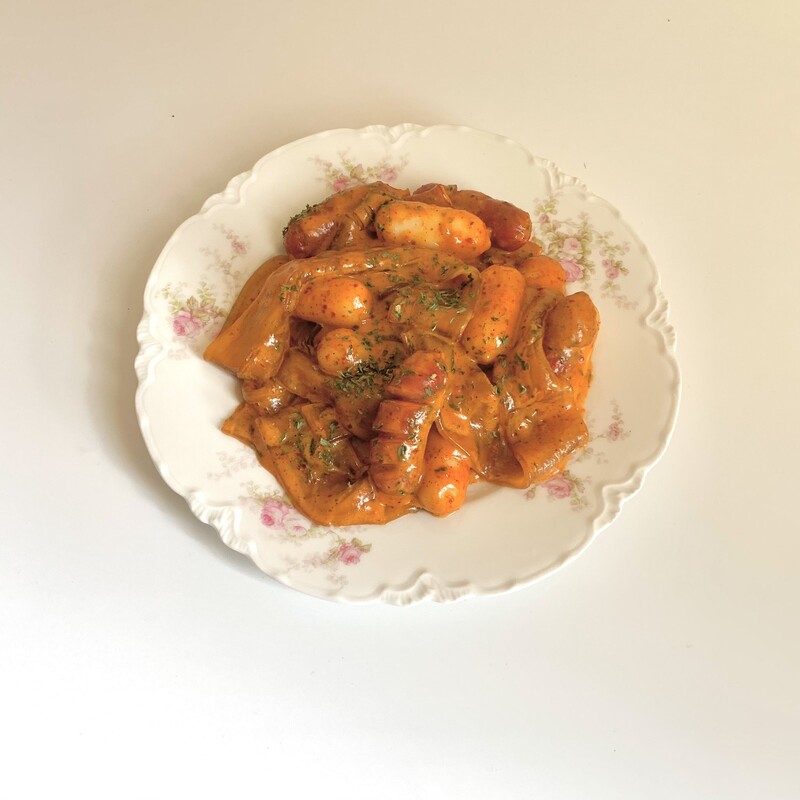Item
A taste of my motherland with a new twist - Rose Tteokbokki
Title (Dublin Core)
A taste of my motherland with a new twist - Rose Tteokbokki
Disclaimer (Dublin Core)
DISCLAIMER: This item may have been submitted in response to a school assignment prompt. See Linked Data.
Description (Dublin Core)
Amid the COVID-19 pandemic, my favorite pastime was watching various cooking and food story-time videos on YouTube. Yet, there was one video in particular that caught my full wide attention. I remember on May 6th, 2021, at around 10:45 pm PST, this video appeared on my YouTube recommendations. The video thumbnail showed one of my favorite Korean street foods, Tteokbokki (Korean spicy stir-fried rice cakes), but with a new twist!
Growing up, I associated Tteokbokki with flavor notes such as the spiciness of the Gochujang and Gochugaru (Korean chili paste and chili powder), the sweetness of the Mulyeot (Korean corn syrup) in which also helps give the rice cakes its glossy shine, as well as using Sogogi dashida (Korean beef stock powder) to further enhance the umami tangy flavor. Of course, there are other variations of Tteokbokki such as Jjajang Tteokbokki (made with Black bean paste) and Gungjung Tteokbokki (made with both Soy sauce and beef) but the modern recipe with the Gochujang never failed to hit all my tastebuds. Well, that was until I discovered the video.
The video used the modern Tteokbokki recipe, but also adding in a new twist with ingredients such as heavy cream and milk to give the Tteokbokki a pink color. Because the Tteokbokki resembled the pink colors of a Rose pasta sauce, it became “Rose Tteokbokki.”
After watching the video and doing some research on Rose Tteokbokki (I ended up staying up till 3 am) I became convinced and made some for brunch.
Making Rose Tteokbokki for brunch was the best decision I ever made because it still kept the delicious flavor notes of the modern recipe but with the extra creaminess and cheesiness thanks to the heavy cream and milk. Also, adding in meats such as sausages and bacon along with Korean wide glass noodles gave the Rose Tteokbokki a unique chewy texture combo.
Once I finished up the Rose Tteokbokki, I posted a picture of the Rose Tteokbokki on my social media accounts, and one of my friends who live in Seoul replied with, “Jungeun! You’re also joining the Rose Tteokbokki bandwagon?! Everyone in Korea is rushing to make their own and/or ordering from the delivery apps because of Covid! Once Covid ends, come visit me and let’s eat Rose Tteokbokki together!” Reading my friend’s response left me with a big smile on my face, and it felt great to connect with the motherland even without physically being there through Rose Tteokbokki.
Growing up, I associated Tteokbokki with flavor notes such as the spiciness of the Gochujang and Gochugaru (Korean chili paste and chili powder), the sweetness of the Mulyeot (Korean corn syrup) in which also helps give the rice cakes its glossy shine, as well as using Sogogi dashida (Korean beef stock powder) to further enhance the umami tangy flavor. Of course, there are other variations of Tteokbokki such as Jjajang Tteokbokki (made with Black bean paste) and Gungjung Tteokbokki (made with both Soy sauce and beef) but the modern recipe with the Gochujang never failed to hit all my tastebuds. Well, that was until I discovered the video.
The video used the modern Tteokbokki recipe, but also adding in a new twist with ingredients such as heavy cream and milk to give the Tteokbokki a pink color. Because the Tteokbokki resembled the pink colors of a Rose pasta sauce, it became “Rose Tteokbokki.”
After watching the video and doing some research on Rose Tteokbokki (I ended up staying up till 3 am) I became convinced and made some for brunch.
Making Rose Tteokbokki for brunch was the best decision I ever made because it still kept the delicious flavor notes of the modern recipe but with the extra creaminess and cheesiness thanks to the heavy cream and milk. Also, adding in meats such as sausages and bacon along with Korean wide glass noodles gave the Rose Tteokbokki a unique chewy texture combo.
Once I finished up the Rose Tteokbokki, I posted a picture of the Rose Tteokbokki on my social media accounts, and one of my friends who live in Seoul replied with, “Jungeun! You’re also joining the Rose Tteokbokki bandwagon?! Everyone in Korea is rushing to make their own and/or ordering from the delivery apps because of Covid! Once Covid ends, come visit me and let’s eat Rose Tteokbokki together!” Reading my friend’s response left me with a big smile on my face, and it felt great to connect with the motherland even without physically being there through Rose Tteokbokki.
Date (Dublin Core)
October 17, 2021
Creator (Dublin Core)
Christina Lee
Contributor (Dublin Core)
Christina Lee
Event Identifier (Dublin Core)
HST643
Partner (Dublin Core)
Arizona State University
Type (Dublin Core)
Photograph
text story
Controlled Vocabulary (Dublin Core)
English
Food & Drink
English
Recreation & Leisure
English
Emotion
Curator's Tags (Omeka Classic)
food
recipe
Rose Tteokbokki
Korea
home
culture
cooking
taste
sensory
Contributor's Tags (a true folksonomy) (Friend of a Friend)
Arizona State University
HST 643
Sensory History
Food
Taste
Motherland
Korea
Collection (Dublin Core)
Foodways
Linked Data (Dublin Core)
Date Submitted (Dublin Core)
10/17/2021
Date Modified (Dublin Core)
10/20/2021
06/27/2023
Item sets
This item was submitted on October 17, 2021 by Christina Lee using the form “Share Your Story” on the site “A Journal of the Plague Year”: http://mail.covid-19archive.org/s/archive
Click here to view the collected data.

